
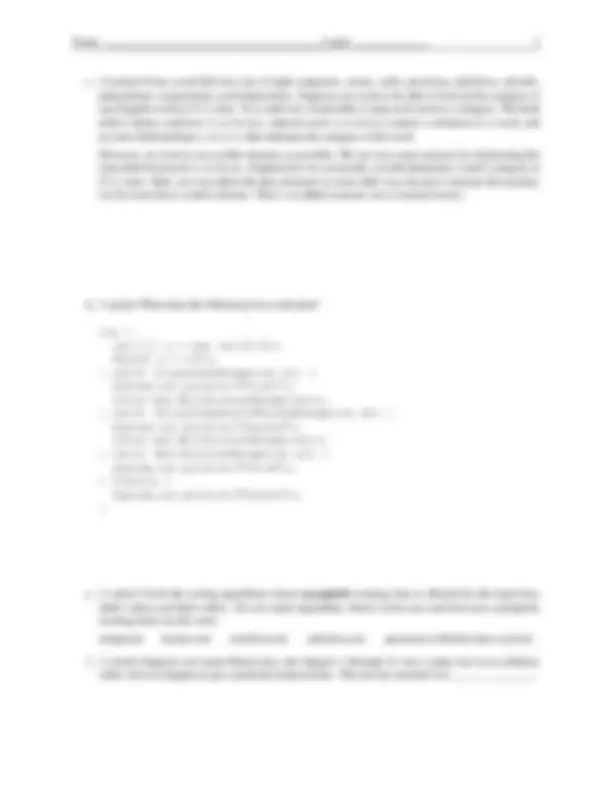
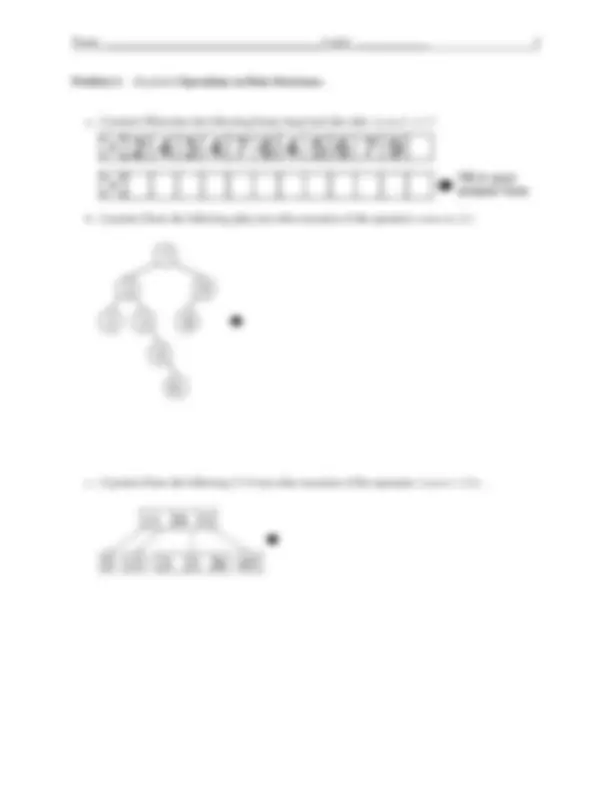
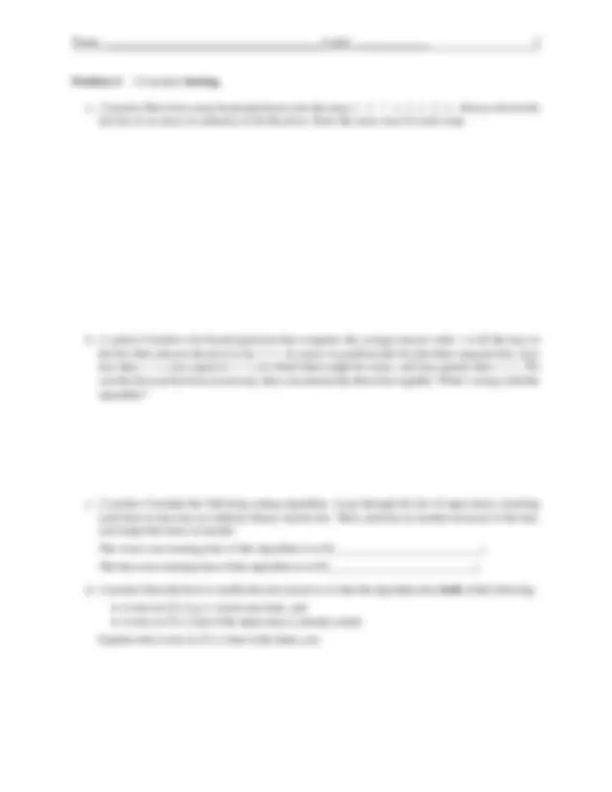
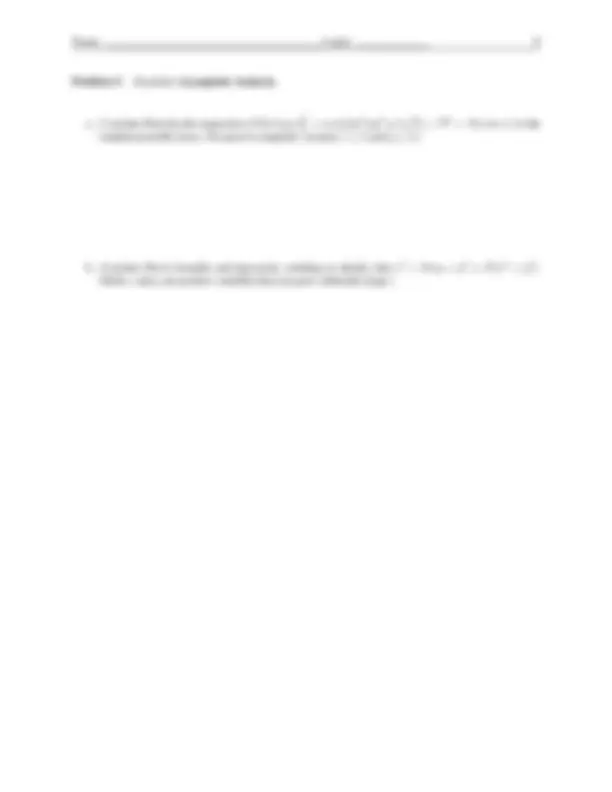
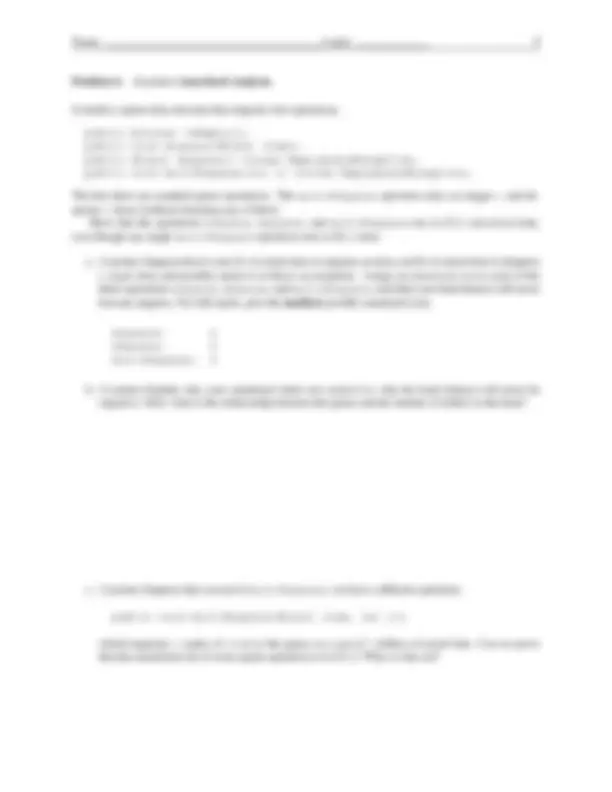



Study with the several resources on Docsity

Earn points by helping other students or get them with a premium plan


Prepare for your exams
Study with the several resources on Docsity

Earn points to download
Earn points by helping other students or get them with a premium plan
Community
Ask the community for help and clear up your study doubts
Discover the best universities in your country according to Docsity users
Free resources
Download our free guides on studying techniques, anxiety management strategies, and thesis advice from Docsity tutors
The final exam for cs 61b (data structures) at the university of california, berkeley for the spring 2005 semester. The exam covers topics such as data structures, augmented trees, asymptotic and amortized analysis, sorting, splay trees, 2-3-4 trees, and augmented binary search trees.
Typology: Exams
1 / 10

This page cannot be seen from the preview
Don't miss anything!







University of California at Berkeley Department of Electrical Engineering and Computer Sciences Computer Science Division
Spring 2005 Jonathan Shewchuk
This is an open book, open notes exam. Electronic devices are forbidden on your person, including cell phones and laptops. Please put them on the desk at the front of the room (and turn your cell phone off) or risk losing a point. Do not open your exam until you are told to do so!
Name:
Login:
Lab TA:
Lab time:
Do not write in these boxes. Problem # Possible Score
Total 50
Problem 1. (8 points) A Miscellany.
a. (2 points) Consider the following method to make all the nodes in a doubly-linked list (circularly linked, with sentinel) available for garbage collection. Recall that head references the sentinel. As- sume that listnodes are referenced only by other listnodes in the same list.
public void garbageList() { if (size > 0) { head.next.prev = null; //? Erase references to sentinel. head.prev.next = null; //? } head.next = null; //? Erase references to other nodes. head.prev = null; //? head = null; }
Are the lines marked with question marks necessary to ensure that all the listnodes are available to be garbage collected? Explain.
b. (1 point) Recall that a SimpleBoard object stores an 8 × 8 array grid in which each cell has value 0, 1, or 2. Suppose you want to store lots of SimpleBoards in a hash table. Can you think of a reason why the following hash code will not distribute SimpleBoard objects evenly among the buckets? (Assume the compression function is good.)
public class SimpleBoard { private int[][] grid;
public int hashCode() { int code = 0; for (int i = 0; i < 8; i++) { for (int j = 0; j < 8; j++) { code = code + (i + j) * grid[i][j]; } } return code; } }
Problem 2. (6 points) Operations on Data Structures.
a. (2 points) What does the following binary heap look like after insert(1)?
b. (2 points) Draw the following splay tree after execution of the operation remove(6).
c. (2 points) Draw the following 2-3-4 tree after execution of the operation insert(30).
Problem 3. (12 points) Sorting.
a. (3 points) Show how array-based quicksort sorts the array 5 9 7 4 0 2 8 8. Always choose the last key in an array (or subarray) to be the pivot. Draw the array once for each swap.
b. (1 point) Consider a list-based quicksort that computes the average (mean) value i of all the keys in the list, then chooses the pivot to be i + 1. As usual, we partition the list into three separate lists: keys less than i + 1, keys equal to i + 1 (of which there might be none), and keys greater than i + 1. We sort the first and last lists recursively, then concatenate the three lists together. What’s wrong with this algorithm?
c. (2 points) Consider the following sorting algorithm. Loop through the list of input items, inserting each item in turn into an ordinary binary search tree. Then, perform an inorder traversal of the tree, and output the items in inorder. The worst-case running time of this algorithm is in Θ( ). The best-case running time of this algorithm is in Θ( ).
d. (2 points) Describe how to modify the tree in part (c) so that the algorithm does both of the following.
Problem 4. (5 points) Augmented Binary Search Trees.
The rank of a key k in a set S is the number of keys in S that are less than or equal to k (including k itself). We want to store S in an ordinary binary search tree so that we can determine the rank of any key in it in O(h) time, where h is the height of the tree. Note that because S is a set, there are no duplicate keys in the tree. Note also that you should not perform rotations or otherwise restructure the tree.
a. (1 point) What information should you store in each node of the tree?
b. (2 points) Let k be a key in S. Describe an algorithm that determines the rank of k in O(d) time, where d is the depth of k in the tree.
c. (2 points) Describe an algorithm that inserts a new key k in O(h) time, where h is the height of the tree. If k is already in the tree, your algorithm should change nothing (as duplicate keys are not allowed). Otherwise, your algorithm must make all necessary adjustments to the information stored in the tree to ensure that your algorithm in part (b) still works.
Problem 5. (6 points) Asymptotic Analysis.
a. (2 points) Rewrite the expression O(8x log 7 y
4 8 + max{^3 y (^4) log^9 y, 5 √x} + 2 2 y (^) + 10x sin x) in the simplest possible form. (No proof is required. Assume x ≥ 2 and y ≥ 2 .)
b. (4 points) Prove formally and rigorously, omitting no details, that x^2 + 10xy + y^2 ∈ O(x^2 + y^2 ). (Both x and y are positive variables that can grow arbitrarily large.)
Problem 7. (7 points) Index Sort.
Write a method indexSort that uses the following algorithm to sort an array x of Thing objects. Loop through the Things in x. For each Thing, calculate what index it will be stored at in the output array y. Obviously, this index depends on the keys of the other Things in the array x. Copy the Thing’s reference from x to y. Note that x may contain duplicate keys, and it is your responsibility to make sure your sort is stable. Your sort should run in O(n^2 ) time, where n is the length of x. For full marks, each Thing’s reference should be copied only once ever. Do not change the array x.
public class Thing { int key; // Use the "key" field as the sort key. Object value;
public static Thing[] indexSort(Thing[] x) { // Returns sorted copy of x. Thing[] y; // Don’t forget to construct a new array.
return y; ___ } Check here if your answer | | } is continued on the back. |___|